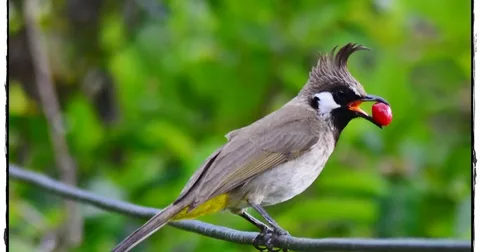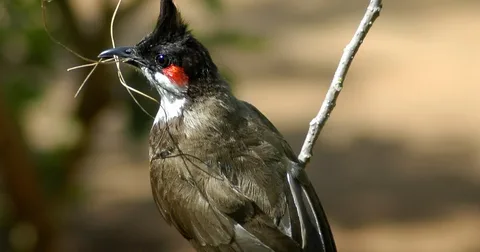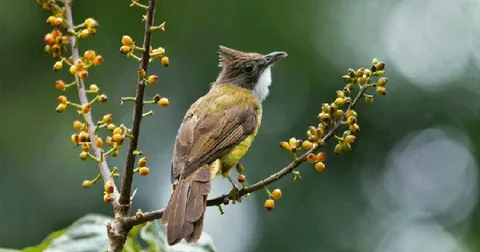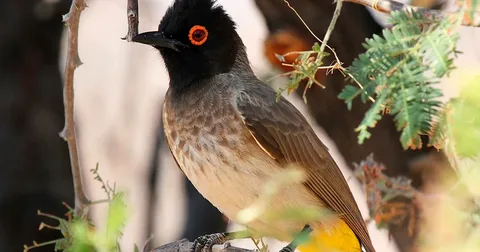Bulbul Birds: Nature’s Living Harbingers of Harmony
The bulbul Birds (family Pycnonotidae) is a captivating songbird celebrated for its soothing vocal melodies, playful energy, and vivid beauty. Scattered across Asia, Africa, the Middle East, and tropical regions, bulbuls are admired not only for their enchanting tunes but also for their ecological value and cultural symbolism. Whether perched upon blooming branches or flitting gracefully through lush greenery, these vibrant avian wonders add life and charm to their surroundings.
1. Distinctive Physical Traits and Elegant Charm

Bulbul Birds are small to medium-sized passerine Bulbul birds, typically ranging between 15 to 25 centimeters in length, yet their exquisite features set them apart in the avian world.
- Plumage Diversity: Depending on the species, their feathers display mesmerizing tones of olive-green, golden-yellow, brown, chestnut, white, or jet black. Among them, the Red-vented Bulbul is especially famous for its dark body, black crested crown, and bright crimson undertail.
- Graceful Tails: Most species exhibit long, slightly forked tails that enhance their aerial elegance.
- Sleek Frames and Agility: Their streamlined bodies and lightweight form allow swift, graceful movements among dense canopies and flowering shrubs.
With over 150 species globally, each bulbul showcases its own distinctive patterns, hues, and vocal nuances, making them a delight for birdwatchers and ornithologists alike.
2. Habitats, Rhythms, and Feeding Behavior Bulbul Birds

- Preferred Homes: While many species thrive in lush, subtropical forests, others—such as the Red-whiskered Bulbul—have adapted seamlessly to city parks and cultivated landscapes.
- Energetic Nature: Known for their restless spirit, bulbuls are often seen darting between trees, hovering near flowers, or leaping gracefully to capture insects mid-flight.
- Eclectic Diet: Bulbuls are omnivorous foragers, consuming a rich variety of berries, figs, nectar, seeds, tender buds, insects, and caterpillars. Their fondness for fruit makes them natural seed dispersers, helping forests regenerate and flourish.
- Sonic Signatures: One of the bulbul’s most enchanting traits is its sweet, melodious call. Their songs range from gentle, flute-like tones to quick, rhythmic chirps, making them living musicians of the wild.
This combination of versatile feeding, adaptability, and melodious vocalizations ensures bulbuls thrive in both natural and human-influenced habitats.
3. Bulbul bird Breeding Rituals and Devoted Parenting

The breeding season for bulbuls typically coincides with spring and early summer, aligning with the abundance of food sources. These birds exhibit remarkable dedication in nurturing their young.
These nests are skillfully hidden in bushes, hedges, or low-hanging branches, ensuring protection from predators.
- Egg Laying: Females usually lay 2 to 4 eggs per clutch, delicately speckled with pink, cream, or pale brown patterns.
- Shared Duties: Unlike many bird species, both parents actively incubate the eggs, guard the nest, and feed the hatchlings.
- Protective Instincts: Bulbuls are bold defenders, fearlessly confronting intruders who dare approach their nesting sites.
Their harmonious teamwork and deep parental devotion not only ensure the survival of their chicks but also symbolize unity and resilience within nature’s design.
4. Cultural Reverence and Ecological Contributions Bulbul Birds

Bulbuls hold immense cultural, symbolic, and ecological importance:
- Cultural Symbolism: In Persian poetry, bulbuls are renowned as messengers of love and longing, while in South Asian traditions, their songs symbolize joy, renewal, and romantic devotion.
- Environmental Role: As seed dispersers and insect controllers, bulbuls maintain ecological balance, enrich plant diversity, and support healthy ecosystems.
- Human Connection: Their sweet melodies have inspired art, literature, and music for centuries, making bulbuls an enduring symbol of natural beauty and harmony.
- Conservation Awareness: Although many species are abundant, habitat destruction and urban expansion threaten certain bulbul populations, emphasizing the need for conservation efforts.
These lively songbirds remind us of the delicate interdependence between humans, wildlife, and their shared environments.
Beautiful Bulbul Birds in the USA
Graceful Appearance of Bulbul Birds
Bulbul birds found in parts of the USA are admired for their gentle presence and attractive looks, especially in regions with warm climates that support their natural behavior. These birds display soft feathers, expressive eyes, and lively movements that make them easy to identify in various habitats across southern states. Their melodic calls create a peaceful atmosphere, attracting bird lovers who appreciate their calm and friendly nature throughout the year. Many people enjoy observing bulbuls during early mornings, when they become most active and show their playful personalities in open spaces. Their ability to adapt to garden areas and wooded landscapes helps them survive comfortably, even when environmental conditions shift unexpectedly. Because of their adaptable nature, bulbuls continue to increase in popularity among American bird enthusiasts.
Habitat and Behavior of Bulbul Birds
Bulbul birds often settle in areas offering reliable food sources, safe nesting spots, and moderate weather, especially across southern USA regions. They prefer fruit-rich habitats, enjoying berries, seeds, and insects that keep them active throughout every season. These birds usually build nests in shrubs or small trees, choosing locations that protect their eggs from predators and harsh winds. Their social behavior includes gentle communication through soft chirps, which help them maintain group harmony during daily routines. Bulbuls also display strong territorial instincts, especially when guarding young ones during nesting periods. Their cooperative nature allows them to thrive in both rural and suburban environments, making them welcome guests for homeowners who enjoy watching wildlife. Their constant movement and bright sounds help maintain ecological balance across their chosen territories.
Importance of Bulbul Birds in the USA Environment
Bulbuls play an important role in the American environment, especially through seed dispersal that supports the healthy growth of native plants. Their habit of feeding on fruits allows them to spread seeds naturally, helping forests and gardens develop stronger ecosystems. These birds also assist in controlling insect populations, reducing the need for harmful chemicals in outdoor areas. Their presence encourages biodiversity, attracting other beneficial species into shared habitats across the USA. Many conservation groups emphasize protecting bulbuls because their survival ensures the long-term stability of natural landscapes across various regions. Their beauty, activity, and ecological value make them meaningful contributors to the country’s environmental health.
Conclusion
With their vibrant plumage, cheerful energy, and ecological significance, bulbuls inspire wonder and appreciation in every habitat they grace. Protecting these avian gems and their surroundings ensures the preservation of their sweet songs and their vital contributions to the planet’s ecosystems.
 Birds Drawing Birds Drawing
Birds Drawing Birds Drawing
